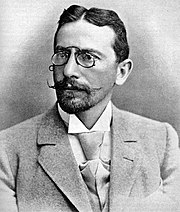Difference between revisions of "Tarrasch Rule"
GerdIsenberg (talk | contribs) (Created page with "'''Home * Evaluation * of Pieces * Tarrasch Rule''' FILE:Tarrasch 72.jpg|border|right|thumb|180px| [https://en.wikipedia.org/wiki...") |
GerdIsenberg (talk | contribs) |
||
| Line 6: | Line 6: | ||
formulated by [https://en.wikipedia.org/wiki/Siegbert_Tarrasch Siegbert Tarrasch], is a [https://en.wikipedia.org/wiki/Rule_of_thumb rule of thumb] (heuristic) applied in [[Endgame|endgames]] and sometimes (late) [[Middlegame|middlegames]] with [[Passed Pawn|passed pawn(s)]] and [[Rook|rook(s)]] involved. Rooks should be placed "behind" own passers as well as [[Candidate Passed Pawn|candidates]] to support them, as well "behind" opponent passers to hold them. | formulated by [https://en.wikipedia.org/wiki/Siegbert_Tarrasch Siegbert Tarrasch], is a [https://en.wikipedia.org/wiki/Rule_of_thumb rule of thumb] (heuristic) applied in [[Endgame|endgames]] and sometimes (late) [[Middlegame|middlegames]] with [[Passed Pawn|passed pawn(s)]] and [[Rook|rook(s)]] involved. Rooks should be placed "behind" own passers as well as [[Candidate Passed Pawn|candidates]] to support them, as well "behind" opponent passers to hold them. | ||
| + | =Advantage= | ||
The advantage of a rook intersecting the passers [[Pawn Spans|rear span]] is that it does not hinder the passer from [[Promotions|queening]], but indirectly controls its [[Stop Square|stop square]] with increasing vertical rook [[Mobility|mobility]] the more the passer advances. Since the passers rear spans might also be occupied by other pieces, specially own or opponent file-immobile pawns, the passer should actually be defended or attacked by a rook from south (white passer) or north (black passer). Alternatively, with [[Bitboards|bitboards]] and [[Fill Algorithms|fill stuff]] in mind, to determine the relevant subset of the rear span, the north- or south [[Dumb7Fill#OccludedFill|Dumb7-]] or [[Kogge-Stone Algorithm#OccludedFill|Kogge-Stone occluded fill]] might be applied, only with pawns of both sides as obstructions. | The advantage of a rook intersecting the passers [[Pawn Spans|rear span]] is that it does not hinder the passer from [[Promotions|queening]], but indirectly controls its [[Stop Square|stop square]] with increasing vertical rook [[Mobility|mobility]] the more the passer advances. Since the passers rear spans might also be occupied by other pieces, specially own or opponent file-immobile pawns, the passer should actually be defended or attacked by a rook from south (white passer) or north (black passer). Alternatively, with [[Bitboards|bitboards]] and [[Fill Algorithms|fill stuff]] in mind, to determine the relevant subset of the rear span, the north- or south [[Dumb7Fill#OccludedFill|Dumb7-]] or [[Kogge-Stone Algorithm#OccludedFill|Kogge-Stone occluded fill]] might be applied, only with pawns of both sides as obstructions. | ||
| + | |||
| + | : <fentt border="double" style="font-size:24pt">..[.]..(.)../..[.]..(.)../..[.]..(.)../..P..(.)../..(.)..p../..(.)..[.]../..(.)..[.]../..(.)..[.]..</fentt> | ||
| + | The green squares of the rear spans are good squares for either white or black rooks | ||
=See also= | =See also= | ||
Latest revision as of 17:15, 15 May 2018
Home * Evaluation * of Pieces * Tarrasch Rule
The Tarrasch Rule,
formulated by Siegbert Tarrasch, is a rule of thumb (heuristic) applied in endgames and sometimes (late) middlegames with passed pawn(s) and rook(s) involved. Rooks should be placed "behind" own passers as well as candidates to support them, as well "behind" opponent passers to hold them.
Advantage
The advantage of a rook intersecting the passers rear span is that it does not hinder the passer from queening, but indirectly controls its stop square with increasing vertical rook mobility the more the passer advances. Since the passers rear spans might also be occupied by other pieces, specially own or opponent file-immobile pawns, the passer should actually be defended or attacked by a rook from south (white passer) or north (black passer). Alternatively, with bitboards and fill stuff in mind, to determine the relevant subset of the rear span, the north- or south Dumb7- or Kogge-Stone occluded fill might be applied, only with pawns of both sides as obstructions.
-
♙
♟
The green squares of the rear spans are good squares for either white or black rooks
